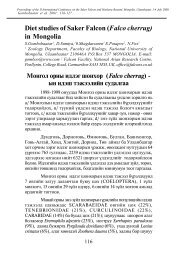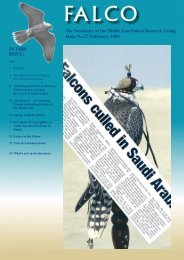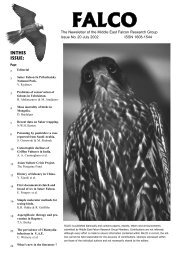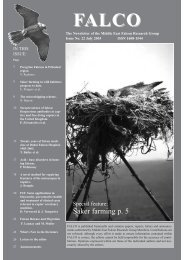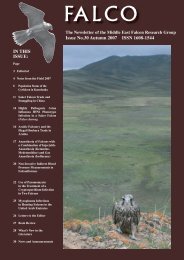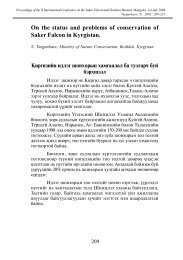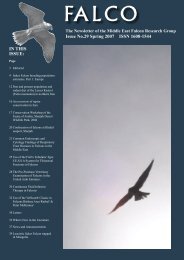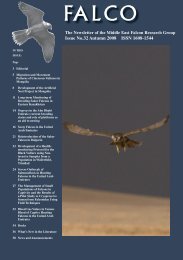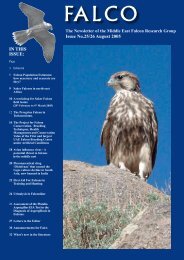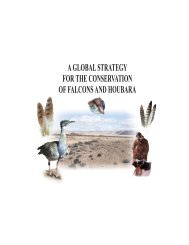Falco cherrug - International Wildlife Consultants Ltd.
Falco cherrug - International Wildlife Consultants Ltd.
Falco cherrug - International Wildlife Consultants Ltd.
Create successful ePaper yourself
Turn your PDF publications into a flip-book with our unique Google optimized e-Paper software.
pesvirus vaccine DuFaHe might be possible (Wernery et al.,<br />
2003).<br />
During the last experiment on falcons we also<br />
infected a Lesser Spotted Eagle subcutaneously with a pathogenic<br />
herpesvirus using the same virus concentration,<br />
which has killed the falcons. The eagle did not show any<br />
clinical signs and did not seroconvert. It seems that eagles<br />
may be refractory to the FHV, but trials on more animals<br />
would be needed to confirm this observation.<br />
References<br />
Heidenreich, M. 1997. Birds of prey. Medicine and management.<br />
Blackwell Science. Pp. 107-113.<br />
Redig, P. T. 1992. Health management of raptors trained for<br />
Recent data on Saker smuggling in China<br />
Ming Ma<br />
Xinjiang Institute of Ecology and Geography, Chinese<br />
Academy of Sciences, 40 Beijing Road, Urumqi 830011,<br />
Xinjiang, P. R. of China, E-mail: aming@ms.xjb.ac.cn,<br />
Cc. maming3211@163.net<br />
Between 2nd and 27th October 2003, a group of<br />
illegal Saker trappers sneaked into Gansu Province , China.<br />
It was reported that there were three men in the group. They<br />
came from Peshawar, Pakistan. It is known there is a major<br />
falcon market in Peshawar, whereas Karachi is the hub for<br />
their eventual export from Pakistan (Mukhtar Ahmed 2003).<br />
Other group of 3 Pakistani men with 3 Sakers were caught<br />
by policeman in Kunjerab Pass, as reported by the of<br />
Xinjiang Radio Station in 30 November 2003.<br />
On 27th Oct., the local police arrested one man on<br />
the Turpan to Korla highway (the other two men escaped).<br />
The arrested man was transporting 7 Saker falcons by taxi.<br />
All were wrapped in plain white cloths and their eyes had<br />
been sewn up. The police approached the Xinjiang Institute<br />
of Ecology and Geography CAS to positively identify the<br />
species and to help in filing the incident. It was suggested<br />
that the falcons be released back into the wild. The arrested<br />
person (and his colleagues) had trapped the Sakers in the<br />
Jiu-quan Area ( 39°50’N, 98°20’E; altitude c. 1500 m ),<br />
Gansu Province, which is an important area on the migrating<br />
route between Mongolia and Tibet (Potapov and Fox,<br />
2002).<br />
Four of the confiscated Sakers had bright yellow or<br />
orange/yellow feet and three had grey blue feet. We know<br />
that colour variation in the feet of the Mongolian population<br />
is huge. Blue feet can be found in very young Sakers where-<br />
falconry. Proc. Assoc. Avian Vet. Pp. 258-264.<br />
Wernery, U., A.L. Sanchez, S. Joseph, and R. Wernery.<br />
2003. <strong>Falco</strong>nid response to the attenuated falcon<br />
herpesvirus vaccine DuFaHe. In: 7 th European<br />
AAV Conference and 5 th ECAMS Scientific<br />
Meeting, Tenerife, Spain, April 22-26. Pp. 191-<br />
196.<br />
Wernery, U., R. Wernery and J. Kinne. 1999. Production of<br />
a falcon herpesvirus vaccine. Berl. Muench.<br />
Tieraerztl. Wschr. 112: 339-344.<br />
Year 1993 1994 1995 1997 1998 1999 2000 2001 2002 2003<br />
Cases 5 8 1 4 3 6 5 1 2 3<br />
Numbers 50 105 8 71 41 114 128 42 11 9<br />
Table 1. Number of cases of illegal trapping of Sakers<br />
during 1993 to 2003 in China<br />
as yellow feet are a sign of Sakers of one year or more. If<br />
the feet are very yellow, it is as a result of a very good and<br />
well-balanced diet (or depends on the level of karatinoids<br />
pigment ).<br />
Table 1 gives the numbers of cases of illegally<br />
caught Sakers in China (Ma 1999, 2003; Wan 2001,2003).<br />
There is a decrease in the number of recorded incidents<br />
since 2001 that may be explained by the following reasons:<br />
A change in the means of transport. Foreign trappers<br />
and smugglers no longer use airplanes or trains to cross<br />
the Chinese boarders: they go by taxi, and always alone. It<br />
is difficult to detect them nowadays.<br />
A change in the trapping area and smuggling route.<br />
Recently groups have come not only to trap in Xinjiang,<br />
western China, but they have also penetrated other Muslim<br />
ranges in the centre of China, e.g. Qinghai, Gansu, Ningxia<br />
etc., from border areas moving inland along the bird migration<br />
routes.<br />
Punishments imposed by China today are stricter<br />
than other countries, and several poachers and smugglers<br />
have been sentenced to many years or life imprisonment,<br />
and even to death.<br />
A total of 8 Sakers were set free near Urumqi by<br />
the local police station on 29th October, 2003. But some<br />
birds were not able to fly any great distance. If people continue<br />
trapping Saker falcons in the Central Asia, the population<br />
will face a serious crisis.<br />
17<br />
References<br />
Ma Ming. 1999. Saker smugglers target western China.<br />
Oriental Bird Club Bulletin 29: 17.<br />
Ma Ming. 2003. The status of Saker <strong>Falco</strong>n population in<br />
the western China. Abstracts of Symposium on<br />
Saker <strong>Falco</strong>n Status in the Range Countries. Abu<br />
Dhabi, UAE, September 23, 2003.<br />
Mukhtar Ahmed, Brigadier. 2003. The status of Saker in<br />
Pakistan. Abstracts of Symposium on Saker <strong>Falco</strong>n<br />
Status in the Range Countries. Abu Dhabi, UAE,



